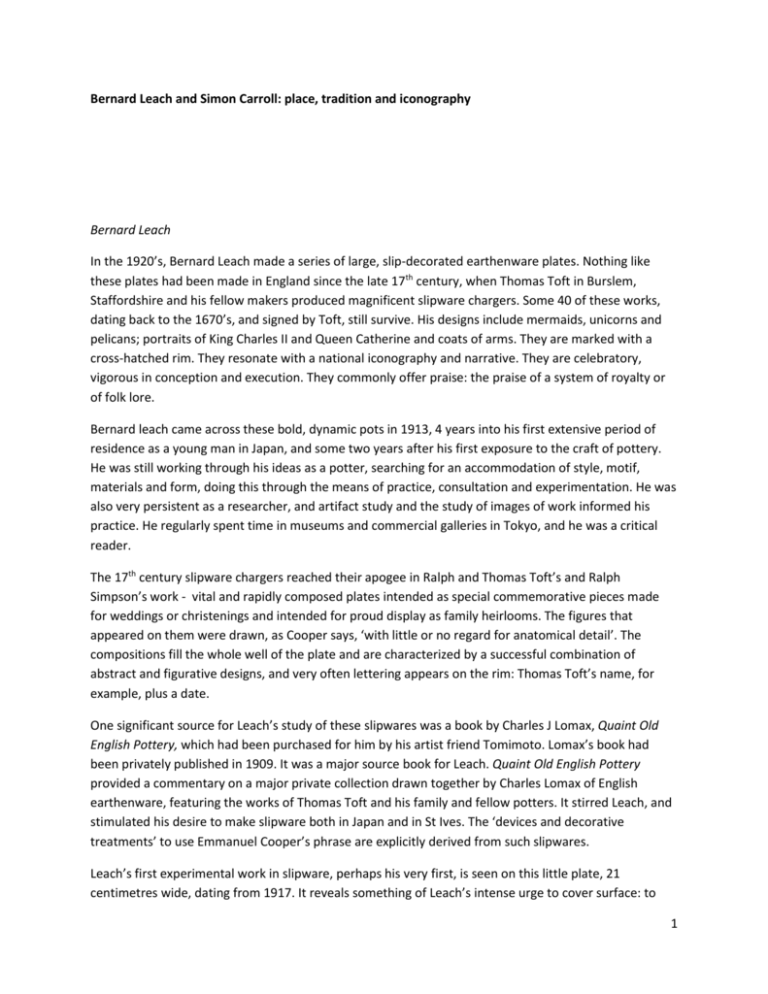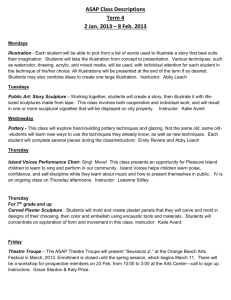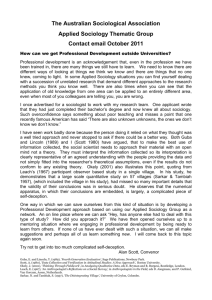Bernard Leach and Simon Carroll
advertisement

Bernard Leach and Simon Carroll: place, tradition and iconography Bernard Leach In the 1920’s, Bernard Leach made a series of large, slip-decorated earthenware plates. Nothing like these plates had been made in England since the late 17th century, when Thomas Toft in Burslem, Staffordshire and his fellow makers produced magnificent slipware chargers. Some 40 of these works, dating back to the 1670’s, and signed by Toft, still survive. His designs include mermaids, unicorns and pelicans; portraits of King Charles II and Queen Catherine and coats of arms. They are marked with a cross-hatched rim. They resonate with a national iconography and narrative. They are celebratory, vigorous in conception and execution. They commonly offer praise: the praise of a system of royalty or of folk lore. Bernard leach came across these bold, dynamic pots in 1913, 4 years into his first extensive period of residence as a young man in Japan, and some two years after his first exposure to the craft of pottery. He was still working through his ideas as a potter, searching for an accommodation of style, motif, materials and form, doing this through the means of practice, consultation and experimentation. He was also very persistent as a researcher, and artifact study and the study of images of work informed his practice. He regularly spent time in museums and commercial galleries in Tokyo, and he was a critical reader. The 17th century slipware chargers reached their apogee in Ralph and Thomas Toft’s and Ralph Simpson’s work - vital and rapidly composed plates intended as special commemorative pieces made for weddings or christenings and intended for proud display as family heirlooms. The figures that appeared on them were drawn, as Cooper says, ‘with little or no regard for anatomical detail’. The compositions fill the whole well of the plate and are characterized by a successful combination of abstract and figurative designs, and very often lettering appears on the rim: Thomas Toft’s name, for example, plus a date. One significant source for Leach’s study of these slipwares was a book by Charles J Lomax, Quaint Old English Pottery, which had been purchased for him by his artist friend Tomimoto. Lomax’s book had been privately published in 1909. It was a major source book for Leach. Quaint Old English Pottery provided a commentary on a major private collection drawn together by Charles Lomax of English earthenware, featuring the works of Thomas Toft and his family and fellow potters. It stirred Leach, and stimulated his desire to make slipware both in Japan and in St Ives. The ‘devices and decorative treatments’ to use Emmanuel Cooper’s phrase are explicitly derived from such slipwares. Leach’s first experimental work in slipware, perhaps his very first, is seen on this little plate, 21 centimetres wide, dating from 1917. It reveals something of Leach’s intense urge to cover surface: to 1 crowd it with a fluid imagery and text, as if to load the plate with thought and reference, and then to free it from this dense context by his depiction of the bird’s rapid flight. It is as if his mind is in tumult, and this tiny surface is all he has to express himself: as a painter, a reader, a critic and student of pottery. This exceptionally rare plate, made in Japan, is a precursor to his large chargers of the 1920’s. The little bird, perhaps a dove, perhaps the symbolic bird of peace, perhaps a sky lark, perhaps the precursor to an elegant cormorant that flies across many of his pots across his long career, is in a kind of rapt flight. The quotation form William Blake’s prophetic Book of Urizen reminds us of the significance of the mystical poet to Leach and to his Japanese friends and artists. Soetsu Yanagi, for example, published a massive volume on Blake in 1914, the first in Japan, dedicating it to Leach. It was a cultural exchange. But there was also an economic dimension to these interplays. Leach wrote in A Potter’s Outlook that: ‘having become a potter in Japan – a land still new to the affairs of industrialization – I did not realize the chasm which a century of factories had torn between ordinary life and hand crafts such as mine. I thought that, as in Japan, the work would speak for itself. But I have been forced to the conclusion that, except for the very few, this is not the case, and that unless the potter, weaver, wheelwright or other craftsman, tells his own tale, no one else will or can do it for him’. And so, in this precursive Japanese-made plate, Leach finds that slip-trailing from 17th century England gives him the essential means to draw together the creative forces of literature and poetry, and through drawing and writing in slip, he can express the individuality of the hand made on the simplest of domestic forms. It is a remarkable little plate: one in which pace, enquiry and reflection are all in flux. This may be a Staffordshire pot as much as a Japanese one. Leach was reflecting on images of Thomas Toft’s slipware chargers and other wares made at Burslem at the same time, and their role as exemplars of an English ‘folk art’. Emmanuel Cooper asserts that ‘their unselfconscious sense of pattern, inventive interpretation and the placing of bold designs struck him as a successful blend of skill and intuitive aesthetic handling’. Leach made at least one larger slipware charger in Japan, a Hare Dish in raku in 1919, now in the collection of the Japan Folk Craft Museum in Tokyo. He gave it to his lifelong friend Soetsu Yanagi and said ‘this was my first attempt after having started making pots in an alien country to get my feet on the ground of English tradition’. He was doing so here by synthesis and study, and he began to realize in 1919 that he could ‘make pottery under circumstances which offer unusually favourable opportunities for the development of his art’. This he would do, from 1920 onwards, in St Ives. Leach slipware chargers formed an important part of his output at The Leach Pottery in Cornwall throughout the 1920s. He followed the style of Thomas Toft by giving them a cross hatched rim and he sometimes signed his works on the rim, as Toft had done before him. But his imagery is remarkable for its individuality, its melding of English and Japanese iconography. He depicts a Japanese Well head; a Griffin from English heraldry; the tree of life; the Pelican in her Piety; a deer, an owl, this last plate placed above the fireplace in the Leach Pottery. Sometimes these images were embedded in the mythology of Cornwall as in the Mermaid of Zennor plate, a dish that for a moment in time Leach 2 intended as a gift to the Crafts Study Centre collection, although it was passed to his son David instead, and is now in the collection of the Harris Museum, Preston. Leach’s slipwares fuse culture: East and West. They fuse time: the chargers of the 1920’s could not have been made without reference to those of the 1680’s. They use the techniques that were appropriate for the job at hand: raku firings at first, the use of Red Devon Clay. They are transitional pots. They were also notoriously difficult to make without error. They often simply exploded in the kiln or misfired. They are prone to damage and often carry deep firing cracks. The glaze does not always cover the surface of the slip painting. But they are also joyous exemplars of vernacular art, and just occasionally after the 1920’s, leach would make a slipware piece perhaps to remind himself of their potency and the vital role they played in the development of his practice and his search for an independent artistic voice. The slipware chargers were also important because they laid out a template for a related series of large plates he made in the 1920’s with iron brushwork rather than slip painting, including one work in the Crafts Study Centre’s collections showing Bali shadow puppets. Leach was to say that ‘only in the remnants of folk life and folk culture will you find what I call pattern. It’s comparable to metaphors, to poems, to tools, little abstract simplifications of sound, colours, shapes which can be repeated quickly as in music or dance or in poetic couplets. William Blake’s are good examples’. As a postscript to Bernard Leach’s slipwares, I want to remark, briefly, on the way that he displayed one charger, in particular. I mean his owl plate, which was situated in the corner fireplace of the Leach Pottery. Two Tang figures from his personal collection of ceramics were placed in the niches above the fireplace. It was a place where Leach settled and performed the role of the pottery master, explaining the finer points of making a jug, plate or mug to his assistants. The Owl charger took pride of place here. After Leach’s death, and perhaps around the time of Janet Leach’s death, these two Tang figures and the owl charger disappeared from the pottery into a private collection in St Ives: perhaps donated by Leach. The Leach Pottery decided some years ago to clear and stabilize the fireplace so that it could be lit again, and in the spirit of recapturing the special significance of this micro site, took steps to reconstruct the tableau of pots that had played such vital testimony to the sense of place and the idea of conversing about ceramics in the sight of exemplar works. The Leach Pottery commissioned Philip Leach (who was born just down the road in Four Marks in 1947), Bernard’s grandson, to make a slipware charger to take the place of the original. Philip takes up the story: ‘Making jugs in the old Leach Pottery St Ives. Full to the brim with memories: Bill Marshall, Scot Marshall, Paul Vibert, Horatio Dunn, Uncle David, my Dad to name a few. Mr Laposter, now, how did you spell his name, a gardener taught me to pull up stinging nettles, just grab them hard! No, it didn’t seem to work. The owl platter was quite a curiosity because Bernard’s original platter was heavily influenced I think by an owl from ‘The Slipware Book’ which inspired a lot of his work at that time…His owl was quite comical – brush drawn, tinted possibly with an iron wash and glazed in galena, I think. I decided to go for a trailed platter white slip on black and a honey glaze. Throwing in the old workshop my back was near an incredibly cold damp wall and by the third morning I had managed to tear a muscle 3 in my lower back. I realized that working out of my comfort zone I was having problems achieving the size of platter for this project. A bit of potter’s bad luck crept in and the kiln managed to crack the two best plates so I was unable to have a worthy piece for the opening of the fireplace. I thoroughly enjoyed the interaction with the visitors passing through and had some good chats…I have just read the correspondence between Yanagi and Bernard from 1912 -1958 and together with my own experience now I feel The Leach Pottery has very much a life of its own. I have persevered and thrown four more platters now measuring about 16” and finished one which I think is worthy of the fireplace’. Simon Carroll It may seem like a cultural wrench to take you from The Leach Pottery to Simon Carroll, but I want to make a case for such a juxtaposition. I can bring geography in to my argument. Bernard Leach settled, as we know, famously in St Ives in 1920 to establish The Leach Pottery. Simon Carroll set up his first studio in his home town of Hereford, but eventually relocated to Cornwall in 2004. Here, he rented an unprepossessing but serviceable Nissen Hut in a disused old airfield near Padstow. Carroll described, in an early artist’s statement, his journey from making domestic wares through to the dramatic, vibrant, sculptural vessels with which he made his reputation as a ceramic artist resonate. In this early artist’s statement he discussed this transition in his practice as well as the significance of his observation of early English slipwares and the part they played in his creative work: ‘ I have been working from traditional hand-made pottery for a while, mainly ;’panchions’ , large old storage pots glazed on the inside and once used in sculleries and kitchens for holding flour and cream. I like to consider the potters who made them, their way of life, attitudes and approaches to the clay, which I feel they probably saw as churning out the carrier bags of their time, having good days and bad days and leaving visible evidence of their experience in their pots; scratches, finger marks, cracks and foreign bodies which affected the glazes. For my most recent work I have looked into 17th and 18th Century slipware, visiting museums to see the pots in the flesh and speaking to the experts to find out exactly how they were made. I am now attempting to create pots in the same way, while adding a few ingredients of my own. I throw my pots using raku, white stoneware, red clay or combinations of these mixed with a large amount of smashed up house brick or tile, which I usually leave thick. I decorate these with white, black and red slip and when they are almost dry I use an old wood saw to cut it up and break off pieces, leaving isolated decoration on the fragments. Each piece is raw glazed and fired to about 1020 to 1060 degrees Centigrade. After firing I examine what I have and re-fire the pieces, adding more glaze in places. Finally I reassemble the pot’. The great flowering of these these tortured ‘slipwares’ (Carroll called them, variously, tall vases, thrown square pots, short vases or thrown square vase on pointed feet, for example) came in 2005 in preparation for his one person touring exhibition curated by Emmanuel Cooper for Tate St Ives. It ended its tour at the Crafts Study Centre in 2007. The Tate curators of the show, Sara Hughes and Susan DanielMcElroy remarked that these works had ‘a compelling unpredictability….whilst firmly rooted in the 4 traditions of English slipware, these works are not politely nostalgic and subvert any expectations of the ubiquitous pot or the perfect form’. Emmanuel Cooper also notes how Carroll’s observation of the history of ceramics, and particularly English slipwares, underpins his ‘understanding and inventive use of material and in the fantasy of figurative, floral and abstract mark-making. His loose, free approach to creating work…is part of a paradoxical quest for both freedom and control, for suggestion and statement’. One might say that what Simon Carroll has taken from slipware is its spontaneity, the need for speed in the mark making, its risk and its joyful expressiveness. Slipware is not an art of restraint here. Carroll prefers an abstract line, although in some commanding vases a leaf like pattern, deeply gouged into the clay, appears. These are profoundly manipulated vessels: hit at, punched at, wrestled and fought over in the manner of Peter Voulkos, for example. Then they are slip-painted with honey and tin glazes. Patches of red earthenware are left untouched, sometimes, to contrast with the free marking and abandoned painting. Every vessel seems both totemically still and feverishly full of movement. Emmanuel Cooper remarks how Carroll’s pots ‘freely thrown, wobbly and wayward, are decorated with spots and drizzles of glaze and splashes of slip in compositions that have all the dynamism and abandon of a Jackson Pollok action painting’. They are pots of Cornwall by way of American Abstract Expressionism. Carroll’s major touring show for Tate St Ives took these cultural references into play with even more vigour: Elizabethan ruffs, 18th century porcelains, decoration on Oribe Wares from Japan are all introduced. He wrote in 2002 that ‘it has always been a good practice for artists to draw and look at tradition. I believe this to be fundamental and enriching’. And it is in this reimagining of slipware that Simon Carroll’s hand reaches down the 20 miles of coast from Padstow to St Ives and touches Leach’s. They both, it seems to me, assimilated a tradition by observation, contemplation, handling and reading. They respected this convention and then ignored aspects of its. They interpreted it in uniquely personal ways. Why is this important to the Crafts Study Centre? First, and prosaically, because the Centre has long held an ambition to acquire a work by Simon Carroll for the collections: both to represent a significant contemporary maker with a fine piece, but also as a counterpoint to our collection of modern slipwares by Leach and Michael Cardew, who contributed so significantly to the development of the genre. And then to stand up against the works by Dylan Bowen and Clive Bowen that we have acquired more recently. The work we have acquired is called Square Vessel with Rounded Feet and was recently displayed in Simon Carroll’s retrospective exhibition ‘Simon Carroll: Expressionist Potter’, at the Victoria & Albert Museum and then touring to the Ruthann Craft Centre. The expert advisors on our Acquisition Committee, Alison Britton and Felicity Aylieff, have been champions of this purchase. Felicity wrote about Carroll in support of the grant applications that he was ‘one of a handful of artist potters to recognize and use the wheel as a creative tool. His inventive and often radical approach towards the generation of form and the application of coloured slips and glazes has had an enormous influence on many who have followed’. To my mind, Carroll’s dominance over clay and the abandoned moment of 5 making is replicated in the work of Sandy Brown, Ashley Howard and Gareth Mason amongst contemporary potters. I made this case to our potential funders (the Art Fund and the V & A Museum Purchase Fund): ‘The work by Simon Carroll is expressive, gnarled, fought over and radical in its shape. Its painting and slip trailing and scorings are done intuitively and at speed. They carry the powerful trace of the hand, not content with a graceful or mannered line, or the need to control the slip trailer with over precision. This is like painting with watercolour: once the mark is applied, it has to stay in place. Everything depends on the moment. One can argue that immediacy and spontaneity are the mark of all studio slipware. Pieces in the Centre’s collections include Pool by Alison Britton, in a style more carefully composed than Carroll’s. Works by Clive Bowen (a large bread bin and vase) contain naturalistic imagery as well as free, abstract lines, but they are expressly functional works. Alison Britton says that “Simon Carroll had an extraordinary verve with the practice of throwing and took it into new and inspiriting territory. But beyond this, and outstanding in my view, was the way the freely painted surface developed with the bravura of the forms, was built up and clawed into by his hands, sloshed with slip and glaze, keeping a sense of the plasticity of clay. This work expresses many of his painter/sculptor concerns in its formal variations from plane to plane”’. Conclusion Leach and Carroll are unlikely companions. But in the re-imagining of English slipware in the 1920’s and in the first decade of the 21st Century, they found common cause as artist potters. The faint spirit of Thomas Toft hovers behind them: and the English tradition of slipware has been immeasurably enriched by what they have achieved. These magnificent and individualistic works also pay due reference to the potters of the past, and unleash their own sense of the worlds of painting, literature and the home. As one critic of Leach’s famously said of an exhibition held in Japan in the 1920’s: ‘we admire your stoneware – influenced by the East – but we love your English slipware – born, not made’. Simon Olding 10 June 2015 Edited from the lecture given to the symposium Shima Kara Shima E 4 December 2014 6 7







